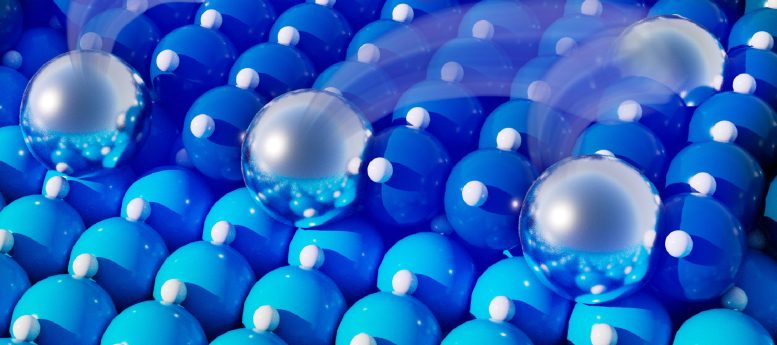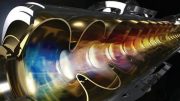
Today’s catalysts for removing unburnt methane from natural gas engine exhaust are either inefficient at low, start-up temperatures or break down at higher operating temperatures. A new single-atom catalyst developed by SLAC National Accelerator Laboratory and Washington State University solves both these problems and removes 90% of the methane. This illustration depicts individual palladium atoms (white) removing methane (white bubbles) at the surface of the catalyst. Credit: Cortland Johnson/Pacific Northwest National Laboratory
Scientists have developed a catalyst using single palladium atoms that can remove 90% of unburned methane from natural gas engine exhaust at low temperatures, offering the potential to significantly lower methane emissions. Further research is underway to advance this promising technology toward commercialization.
Pioneering Catalyst Technology
A catalyst using a single or just a few palladium atoms removed 90% of unburned methane from natural gas engine exhaust at low temperatures in a recent study. While more research needs to be done, the advance in single atom catalysis has the potential to lower exhaust emissions of methane, one of the worst greenhouse gases that traps heat at about 25 times the rate of carbon dioxide.
Promising Findings in Engine Emission Control
Reporting in the journal, Nature Catalysis, a research effort between Washington State University and SLAC National Accelerator Laboratory showed that the single-atom catalyst was able to remove methane from engine exhaust at lower temperatures, less than 350 degrees Celsius (662 degrees Fahrenheit), while maintaining reaction stability at higher temperatures.
“It’s almost a self-modulating process which miraculously overcomes the challenges that people have been fighting – low temperature inactivity and high temperature instability,” said Yong Wang, Regents Professor in WSU’s Gene and Linda Voiland School of Chemical Engineering and Bioengineering and a corresponding author on the paper.
The Challenges of Natural Gas Engines
Natural gas engines are used in about 30 million to 40 million vehicles worldwide and are popular in Europe and Asia. The gas industry also uses them to run compressors that pump natural gas to people’s homes. They are generally considered cleaner than gasoline or diesel engines, creating less carbon and particulate pollution.
However, when these natural gas-powered engines start up, they emit unburnt, heat-trapping methane because their catalytic converters don’t work well at low temperatures. The catalysts for methane removal are either inefficient at lower exhaust temperatures or they severely degrade at higher temperatures.
The Importance of Methane Control
“There’s a big drive towards using natural gas, but when you use it for combustion engines, there will always be unburnt natural gas from the exhaust, and you have to find a way to remove that. If not, you cause more severe global warming,” said co-author Frank Abild-Pedersen, a staff scientist at SLAC National Accelerator Laboratory. “If you can remove 90% of the methane from the exhaust and keep the reaction stable, that’s tremendous.”
A single-atom catalyst with the active metals singly dispersed on a support also uses every atom of the expensive and precious metals, Wang added.
“If you can make them more reactive, that’s the icing on the cake,” he said.
Effective Methane Removal With Single Palladium Atoms
In their work, the researchers were able to show that their catalyst made from single palladium atoms on a cerium oxide support efficiently removed methane from engine exhaust, even when the engine was just starting.
They found that trace amounts of carbon monoxide that are always present in engine exhaust played a key role in dynamically forming active sites for the reaction at room temperature. The carbon monoxide helped the single atoms of palladium migrate to form two- or three-atom clusters that efficiently break apart the methane molecules at low temperatures.
Then, as the exhaust temperatures rose, the sub-nanometer-sized clusters re-dispersed to single atoms again so that the catalyst was thermally stable. This reversible process enables the catalyst to work effectively and uses every palladium atom the entire time the engine was running – including when it started cold.
Moving Towards Commercialization
Christopher Tassone, a SLAC National Accelerator Laboratory staff scientist and co-author on the paper, praised the team’s ability to keep the palladium catalyst stable and highly active, attributing it to the team’s diverse expertise. He said, “We were really able to find a way to keep the supported palladium catalyst stable and highly active and because of the diverse expertise across the team, to understand why this was occurring.”
While the researchers seek to further improve the catalyst technology and better understand why palladium behaves differently from other precious metals like platinum, they acknowledge that the research is some way from being incorporated into vehicles. However, collaboration is underway with industry partners and Pacific Northwest National Laboratory to move the technology closer to commercialization.
Reference: “Dynamic and reversible transformations of subnanometre-sized palladium on ceria for efficient methane removal” by Dong Jiang, Gang Wan, Joakim Halldin Stenlid, Carlos E. García-Vargas, Jianghao Zhang, Chengjun Sun, Junrui Li, Frank Abild-Pedersen, Christopher J. Tassone and Yong Wang, 20 July 2023, Nature Catalysis.
DOI: 10.1038/s41929-023-00983-8
In addition to Wang, Abild-Pedersen, and Tassone, Dong Jiang, senior research associate in the Voiland School, also led the work. The work was funded by the U.S. Department of Energy’s Office of Basic Energy Sciences.









“Scientists have developed a catalyst using single palladium atoms that can remove 90% of unburned methane from natural gas engine exhaust …”
It doesn’t “remove” the methane by sequestering it or recycling it. What it does is convert it into water vapor and carbon dioxide (effectively ‘burning’ the methane at low temperature), along with waste heat that will contribute to the Urban Heat Island effect. It would probably be better to find a way to make the engines start-up quicker and more efficiently, thus using the energy of oxidation to do productive work rather than just producing waste heat and a different GHG.
Besides that, the role of methane as a ‘greenhouse gas’ is overstated: https://wattsupwiththat.com/2023/03/06/the-misguided-crusade-to-reduce-anthropogenic-methane-emissions/